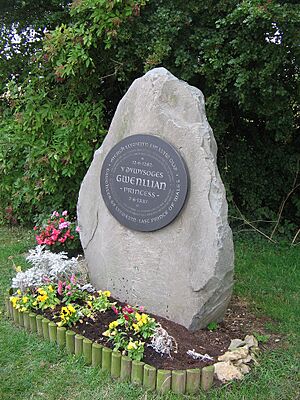Gwenllian of Wales facts for kids
Quick facts for kids Gwenllian of Wales |
|
|---|---|
| Born | June 1282 Abergwyngregyn, Wales |
| Died | 7 June 1337 (aged 54–55) Sempringham Priory, Lincolnshire, England |
| House | Aberffraw |
| Father | Llywelyn ap Gruffudd |
| Mother | Eleanor de Montfort |
Gwenllian of Wales (born June 1282, died June 1337) was a Welsh princess. She was the only daughter of Llywelyn ap Gruffudd, who was the last native Prince of Wales. This means he was the last Welsh ruler of Wales before England took over. Gwenllian is sometimes called Gwenllian ferch Llywelyn, which means 'Gwenllian, daughter of Llywelyn' in Welsh.
Contents
A Royal Welsh Princess
Gwenllian (say it like gwen-HLI-an) was born in June 1282. Her birthplace was the royal home in Abergwyngregyn, a village near Bangor in Gwynedd, Wales. Sadly, her mother, Eleanor de Montfort, died very soon after Gwenllian was born.
Gwenllian had a very special family background. She was not only the daughter of the Prince of Gwynedd, making her a princess of the House of Aberffraw, but she also had English royal blood. Her great-grandfather on her mother's side was King John of England.
Captured by King Edward I
Just a few months after Gwenllian was born, the English army surrounded northern Wales. This army was led by King Edward I of England.
On December 11, 1282, Gwenllian's father, Llywelyn ap Gruffudd, was killed in battle. The exact details of his death are not fully clear. However, most stories agree that Llywelyn was tricked into leaving his main army. Then, he was attacked and killed.
Gwenllian's uncle, Dafydd ap Gruffudd, took care of her after her father died. But on June 21, 1283, Dafydd and his family were captured. They were found hiding in a secret spot in a bog near Bera Mawr in northern Wales. Dafydd was badly hurt. He was taken to Rhuddlan and then to Shrewsbury, where he was later executed.
Life in Confinement
Gwenllian and her cousins, the daughters of her uncle Dafydd, were sent away. They were kept in quiet religious houses called priories in Lincolnshire, England. They were never allowed to be free.
Gwenllian was placed in the Gilbertine Priory at Sempringham. She stayed there for 54 years until she died. King Edward I sent her to a convent to stop her from becoming a symbol for the Welsh people. He didn't want her to marry and have sons who might try to claim the Welsh throne.
The English Crown did recognize Gwenllian's royal status at least once. When King Edward I wrote to the Pope, he asked for more money for Sempringham Priory. He said that "herein is kept the Princess of Wales, whom we have to maintain." This shows they knew she was a princess, even though she was a prisoner.
Gwenllian was taken from Wales when she was very young. It's likely she didn't remember any Welsh language she might have learned as a baby. She might not have even known how to say her own name correctly. The people at the priory wrote her name as "Wencilian." She herself signed her name as "Wentliane."
Later Life and Passing
Edward III of England, who was King Edward I's grandson, gave Gwenllian a yearly payment of £20. This money wasn't for her personally. It was paid to the priory to cover her food and clothes. The priory's records show that she died there in June 1337. She passed away just a few days before her 55th birthday.
The Fate of Her Cousins
Dafydd's two young sons were Gwenllian's male cousins. They were heirs to the Welsh principality. They were taken to Bristol Castle and held prisoner. Llywelyn ap Dafydd died there in 1287, four years after he was captured. His brother, Owain ap Dafydd, lived longer. The exact date of his death is unknown. However, it was after 1305. That year, the King of England ordered a special cage made of wood and iron for Owain. This was to hold him more securely at night.
King Edward I later took the title "Prince of Wales" for the English Crown. He gave this title to his own son, Edward, in 1301. This title is still given to the person who will inherit the British crown today.
Remembering Gwenllian Today
- A special memorial made of Welsh granite stands near Saint Andrew's Church in Sempringham. This church is sometimes called Sempringham Abbey by local people. There is also a display about Gwenllian inside the church.
- Gwenllian has been honored in poetry. A poem called "Gwenllian" by T. James Jones was inspired by her memorial stone. Another poem, "In Sempringham," was written by Mererid Hopwood. She was the first woman to win the Bardic Chair at the National Eisteddfod. This is Wales' highest award for poetry.
- On September 26, 2009, a mountain peak in Snowdonia was officially renamed Carnedd Gwenllian. It was previously called Carnedd Uchaf. This happened after a long campaign by the Princess Gwenllian Society. The Ordnance Survey (mapmakers) added both names, Carnedd Uchaf / Carnedd Gwenllian, to their maps starting in 2010.
- A plaque has also been placed on a rock near the top of Snowdon. It remembers "the Princess Gwenllian (1282-1337), only child of Prince Llewelyn ap Gruffudd, Lord of Snowdonia, Prince of Wales."
Images for kids





